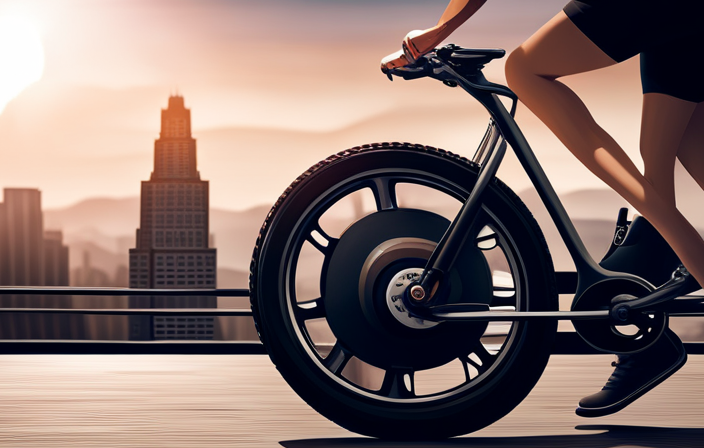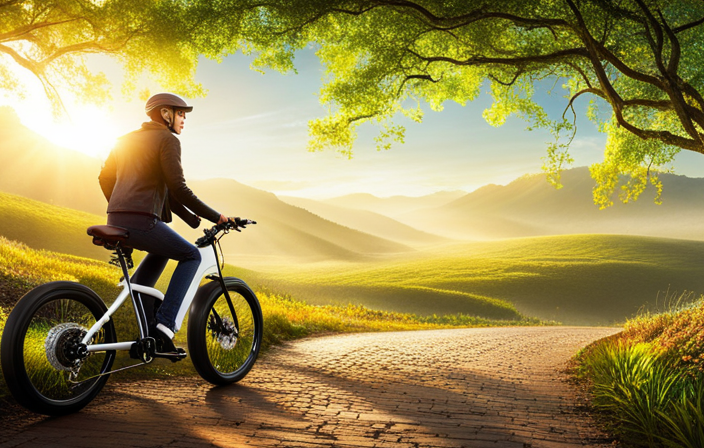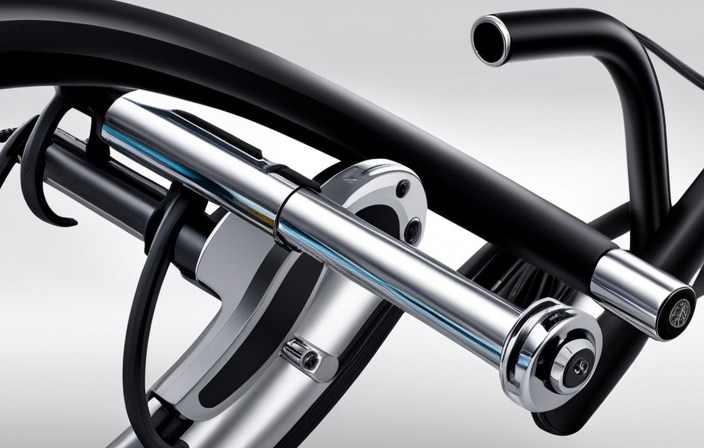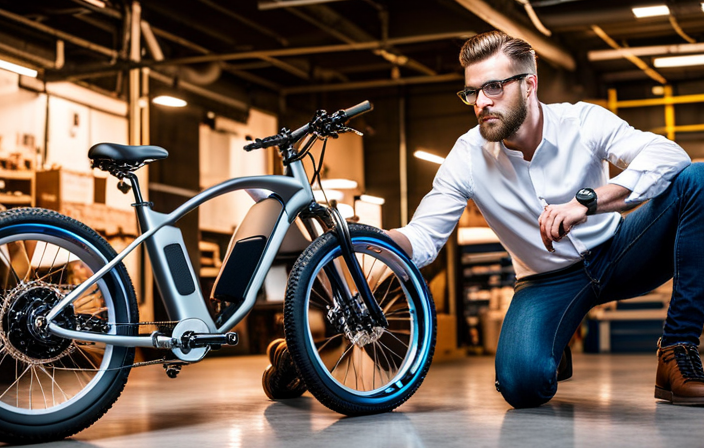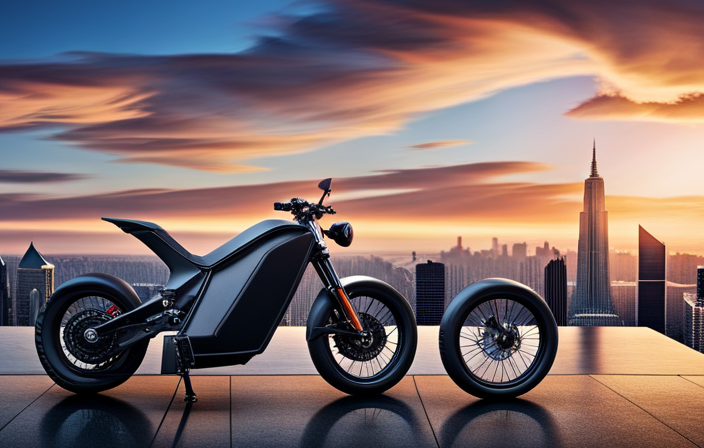I have always been intrigued by the power and efficiency of electric bikes. When I initially began my research, I was amazed by the range of wattages offered. This made me question, ‘How many watts should an electric bike ideally have?’
Well, after diving deep into the world of electric bike technology, I’ve discovered some valuable insights that I can’t wait to share with you. So, buckle up and get ready to explore the ideal wattage for different riding scenarios, budget considerations, maintenance tips, and more.
Let’s embark on this electric bike journey together!
Key Takeaways
- Higher wattage provides more power and torque for steep inclines and higher speeds.
- Factors like rider weight, terrain, and desired speed should be considered when choosing wattage.
- Balancing power and battery efficiency is important when selecting the wattage for an electric bike.
- Seeking advice from electric bike retailers and enthusiasts can help in determining the ideal wattage for specific riding scenarios.
Understanding Electric Bike Wattage
To understand electric bike wattage, you need to know how many watts should your electric bike have. The wattage of an electric bike refers to the power output of its motor. It is an important factor that directly affects the performance of the bike.
Several factors can impact the performance of an electric bike, such as the weight of the rider, terrain, and desired speed. A higher wattage motor will provide more power and torque, allowing the bike to handle steep inclines and reach higher speeds. However, it is important to consider the impact on battery life.
Higher wattage motors tend to consume more energy, which can lead to a shorter battery life. It is essential to find a balance between power and battery efficiency when choosing the wattage for your electric bike.
Factors to Consider When Choosing Wattage
Consider factors like your weight, terrain, and desired speed when choosing the wattage for your e-bike. The ideal wattage for commuting depends on various factors that affect the overall performance and efficiency of your electric bike. Here are some key considerations to keep in mind:
- Weight: Heavier riders may require higher wattage to achieve desired speeds and maintain consistent performance.
- Terrain: If you’ll be riding on hilly or rough terrain, a higher wattage motor will provide the necessary power for climbing steep inclines or navigating challenging surfaces.
- Desired Speed: If you prefer faster speeds, a higher wattage motor will enable you to achieve higher velocities more easily.
- Battery Capacity: Higher wattage motors tend to consume more power, so ensure that your battery has sufficient capacity to support your desired wattage level.
- Budget: Higher wattage motors are generally more expensive, so consider your budget when choosing the ideal wattage for your commuting needs.
Taking these factors into account will help you determine the ideal wattage for your e-bike, ensuring optimal performance and a satisfying commuting experience.
Now, let’s delve into the ideal wattage for city commuting.
Ideal Wattage for City Commuting
When determining the ideal wattage for city commuting, it’s important to take into account factors such as traffic conditions and the distance of your daily commute. Evaluating the efficiency of an electric bike is crucial to ensure a smooth and comfortable ride. Lower wattage can offer several benefits in a city setting. Firstly, it can increase the range of your bike, allowing you to travel longer distances without recharging. Secondly, it can improve the overall efficiency of the bike, leading to better energy consumption and a longer battery life. To give you a better understanding, here is a table showcasing the recommended wattage for different types of city commutes:
| Distance (miles) | Traffic Conditions | Recommended Wattage |
|---|---|---|
| 1-5 | Light | 250-500 |
| 5-10 | Moderate | 500-750 |
| 10+ | Heavy | 750-1000 |
Considering these factors, a lower wattage can be more suitable for city commuting, ensuring an efficient and enjoyable ride. Now, let’s delve into the optimal wattage for off-road adventures.
Optimal Wattage for Off-Road Adventures
If you’re planning to go on off-road adventures, it’s crucial to determine the optimal wattage for a smoother and more powerful ride. When it comes to extreme terrains, having a higher wattage can make a significant difference in your off-road biking experience.
The benefits of higher wattage for off-road biking are numerous. Firstly, it provides more torque, allowing you to conquer steep inclines and rugged terrains with ease. Secondly, it offers enhanced acceleration, enabling you to quickly maneuver through challenging obstacles. Additionally, higher wattage ensures that you have enough power to tackle any off-road trail without experiencing any performance issues.
With the optimal wattage for extreme terrains, you can confidently go on thrilling off-road adventures.
Now, let’s transition into discussing wattage recommendations for recreational riding.
Wattage Recommendations for Recreational Riding
To enjoy your recreational rides to the fullest, it’s important to find the wattage that suits your preferred level of intensity and performance. When choosing the right wattage for your electric bike, there are several factors to consider. Evaluating motor power and wattage ratings is crucial in determining the ideal wattage for recreational riding.
One important factor to consider is the terrain you will be riding on. Steeper inclines and rough terrains require higher wattage to maintain speed and power. Another factor is your fitness level and desired level of assistance. If you prefer a more intense workout, a lower wattage motor will provide less assistance, requiring you to exert more effort. On the other hand, if you want a more leisurely ride, a higher wattage motor can provide greater assistance.
To help you understand the different wattage options available, here is a table showcasing some common wattage ranges and their corresponding features:
| Wattage Range | Motor Power | Performance Level |
|---|---|---|
| 250-500W | Moderate | Intermediate |
| 500-750W | High | Advanced |
| 750W+ | Extreme | Professional |
As you can see, the wattage range directly affects the motor power and performance level of the electric bike. Consider your riding preferences and goals when selecting the appropriate wattage for recreational riding.
When it comes to wattage for touring and long-distance travel, a different set of considerations come into play.
Wattage for Touring and Long-Distance Travel
For touring and long-distance travel, you’ll want to consider a higher wattage motor to ensure you have the necessary power and assistance for those extended rides. When it comes to wattage for daily commuting, a lower wattage motor, around 250-500 watts, is generally sufficient for most urban environments. However, if you live in a hilly area or encounter steep inclines on your commute, you may want to opt for a higher wattage motor, such as 750 watts or more, to provide the extra power needed to conquer those challenging terrains.
It’s important to remember that the higher the wattage, the more power and assistance you’ll have at your disposal. With that in mind, let’s now transition to the next section where we’ll discuss wattage considerations for electric mountain biking.
Wattage Considerations for Electric Mountain Biking
When it comes to tackling the challenging terrains of electric mountain biking, you’ll want to ensure your motor’s wattage is high enough to provide the necessary power and assistance. Understanding power requirements is crucial in choosing the right electric bike for your off-road adventures.
Here are the benefits of higher wattage:
- Increased climbing ability: Higher wattage motors can deliver more torque, allowing you to conquer steep inclines with ease.
- Enhanced acceleration: A higher wattage motor provides a quicker response, giving you a burst of speed when you need it most.
- Extended battery life: With higher wattage, the motor can operate more efficiently, maximizing the range of your electric mountain bike.
Considering these factors, it’s clear that having a higher wattage motor offers numerous advantages for electric mountain biking.
Now, let’s delve into the topic of wattage for electric bike conversion kits.
Wattage for Electric Bike Conversion Kits
Transition: Now that we have discussed the wattage considerations for electric mountain biking, let’s shift our focus to wattage for electric bike conversion kits.
As an enthusiast who has converted my own bike into an electric one, I understand the importance of selecting the right wattage for the conversion kit. To help you make an informed decision, I have created a table below that highlights the understanding of motor efficiency and the benefits of higher wattage.
| Motor Efficiency | Benefits of Higher Wattage | Cost of Higher Wattage | Recommendation |
|---|---|---|---|
| Increased power output | Improved acceleration and speed | Higher cost of components | Ideal for hilly terrains or heavy loads |
| Reduced energy consumption | Enhanced climbing ability | Increased initial investment | Suitable for long-distance commuting |
| Longer battery life | Better performance in off-road conditions | Additional maintenance requirements | Perfect for adventurous riders |
By considering these factors, you can determine the appropriate wattage for your electric bike conversion kit based on your specific needs and preferences.
Transition: Now that we have explored the wattage considerations for electric bike conversion kits, let’s delve into the legal restrictions on electric bike wattage.
Legal Restrictions on Electric Bike Wattage
To ensure compliance with legal regulations, it’s important to be aware of the maximum wattage allowed for electric bike conversion kits in your area.
There are several factors that influence these restrictions. These include safety concerns, environmental impact, and the classification of electric bikes.
Safety concerns are a major factor in determining wattage limits. Higher wattage motors can generate more power and speed, which increases the risk of accidents and injuries. To protect riders and other road users, authorities enforce wattage limits to maintain a balance between performance and safety.
Environmental impact is another consideration. Electric bikes with higher wattage motors consume more energy, which can have a greater environmental impact. By setting wattage restrictions, authorities aim to promote sustainability and reduce carbon emissions.
The classification of electric bikes also plays a role in determining wattage limits. Different jurisdictions classify electric bikes based on their wattage and speed capabilities. These classifications help determine the legal requirements and restrictions applicable to electric bike riders.
Exceeding the legal wattage limits can have serious implications. It may result in fines, legal consequences, and even the invalidation of insurance coverage. Therefore, it’s crucial to understand and adhere to the wattage restrictions in your area to avoid these consequences.
Once you are aware of the wattage limits, evaluating motor power and wattage ratings is the next step in determining the appropriate wattage for your electric bike.
Evaluating Motor Power and Wattage Ratings
Moving on from the legal restrictions on electric bike wattage, let’s now delve into the process of evaluating motor power and wattage ratings.
When it comes to selecting the right electric bike, it is crucial to understand the efficiency of the motor and its impact on battery life. Evaluating motor efficiency involves considering factors such as power output, torque, and overall performance.
Higher wattage ratings generally indicate a more powerful motor, which can provide greater speed and acceleration. However, it is essential to strike a balance between power and battery life. A higher wattage motor may consume more energy, resulting in reduced battery life.
Therefore, it is crucial to carefully assess your needs and usage patterns to determine the appropriate wattage for your electric bike.
To gain further insight, let’s move on to the next section about test riding and consulting experts to help you make an informed decision.
Test Riding and Consulting Experts
When it comes to finding the perfect wattage for my electric bike, I believe in trying different options to determine my personal preference.
I have found that seeking advice from electric bike retailers is a great way to gain insight into the different wattages available and their corresponding performance levels.
Additionally, consulting with electric bike enthusiasts and communities has proven to be invaluable in understanding the real-world experiences and recommendations of those who have already explored the various wattage options.
Trying Different Wattages for Personal Preference
Experiment with different wattages to find the perfect power level for your personal preference.
When it comes to electric bikes, the wattage plays a crucial role in determining the performance and efficiency of the bike. Here are three key considerations to keep in mind when trying different wattages:
-
Cost vs Performance: Higher wattage motors generally come with a higher price tag. However, they also offer better performance, especially when it comes to climbing hills or carrying heavier loads. It’s important to weigh your budget against the desired performance to find the right balance.
-
Battery Life: The wattage of the motor directly affects the battery life of the electric bike. Higher wattage motors tend to drain the battery faster, requiring more frequent recharges. If you prioritize longer rides without worrying about battery life, a higher wattage motor might be suitable for you.
-
Wattage Range: Different electric bikes offer various wattage options. It’s worth experimenting with different wattages to determine which range suits your riding style and needs. Some riders may prefer a lower wattage for a more relaxed ride, while others may opt for a higher wattage for a more powerful and energetic experience.
Finding the right wattage for your electric bike is a personal journey that requires testing and adjusting. Once you have an idea of your preferred wattage range, seeking advice from electric bike retailers can further enhance your decision-making process.
Seeking Advice from Electric Bike Retailers
Seeking advice from electric bike retailers can provide valuable insights and recommendations for finding the right wattage range for your personal needs. These experts have extensive knowledge about the different models and specifications available in the market. They can assess your requirements, such as the terrain you’ll be riding on, your weight, and the distance you plan to cover. Based on these factors, they can provide wattage recommendations that will ensure optimal performance and efficiency.
Electric bike retailers understand the technical aspects of wattage and can explain how it affects the bike’s power and speed. By consulting with them, you can make an informed decision and choose an electric bike with the appropriate wattage range.
Moving forward, consulting electric bike enthusiasts and communities can further enhance your understanding and help you explore additional factors to consider when selecting an electric bike.
Consulting Electric Bike Enthusiasts and Communities
To gain more insights on electric bikes, you can connect with electric bike enthusiasts and communities who can share their experiences and recommendations. These individuals have extensive knowledge about electric bike performance and can provide valuable insights on various aspects, including the impact of wattage on battery life. By engaging with these enthusiasts and communities, you can learn about the different wattage options available in the market and understand how they affect the overall performance of an electric bike. To help you visualize the impact of wattage on battery life, here’s a simple table:
| Wattage | Battery Life |
|---|---|
| 250W | 40-60 miles |
| 500W | 30-50 miles |
| 750W | 20-40 miles |
As you can see, higher wattage often results in reduced battery life. However, it’s important to note that other factors such as terrain, rider weight, and riding style can also influence battery life. Considering these insights, let’s now delve into budget considerations for higher wattage electric bikes.
Budget Considerations for Higher Wattage
When considering the budget for an electric bike, it’s important to take into account the cost of models with more power. Higher wattage typically means a higher price tag, but it’s crucial to balance the wattage with other features and components.
Additionally, it’s essential to consider the long-term cost savings and investment value of an electric bike. Opting for a more powerful model may result in greater efficiency and durability over time.
Cost of Electric Bike Models with More Power
The cost of electric bike models with more power can vary significantly. When comparing cost versus performance, it is important to consider the power versus range of the bike.
Higher wattage motors generally provide more power, allowing for faster acceleration and better performance on challenging terrains. However, this increased power often comes at the expense of range.
The more power a motor has, the more energy it consumes, resulting in a shorter battery life and reduced range. Therefore, it is essential to strike a balance between wattage and other features and components that contribute to the overall performance and efficiency of the electric bike.
Balancing Wattage with Other Features and Components
Finding the right balance between wattage and other features and components is crucial when choosing an electric bike. Evaluating battery capacity and comparing motor efficiency are key factors in this process.
A higher wattage motor typically provides more power and speed, but it can also drain the battery faster. It’s important to consider your specific needs and usage patterns. If you plan on longer rides or tackling hilly terrains, a higher wattage motor might be necessary. However, if you primarily ride on flat surfaces or have a shorter commute, a lower wattage motor could be sufficient.
It’s also important to consider the weight of the bike and your own body weight, as these factors can affect the overall performance.
Long-Term Cost Savings and Investment Value
Transitioning from the previous subtopic of balancing wattage with other features and components, it is important to consider the long-term cost savings and investment value of an electric bike. While higher wattage may initially come with a higher price tag, it can provide significant long-term benefits.
One of the key advantages of investing in a high-wattage electric bike is its energy efficiency. With more power, the bike can cover longer distances and tackle steeper terrains with ease, reducing the strain on the battery and maximizing its range. This increased efficiency translates to cost savings by reducing the frequency of recharging or replacing the battery.
Moreover, high-wattage electric bikes often have a higher return on investment due to their superior performance and durability. With a more powerful motor, the bike can handle various riding conditions, ensuring a smoother and more enjoyable experience. Additionally, the robust components used in high-wattage models tend to require less maintenance and have a longer lifespan, further contributing to their value.
Not only do high-wattage electric bikes offer financial advantages, but they also have a positive environmental impact. By using an electric bike instead of a car, you can significantly reduce your carbon footprint and contribute to a cleaner and greener environment.
In conclusion, opting for a high-wattage electric bike can provide long-term cost savings, a higher return on investment, enhanced energy efficiency, and a reduced environmental impact. Taking these factors into account, it becomes clear that considering wattage is a crucial aspect when choosing an electric bike.
Transitioning into the subsequent section about maintenance and care for high-wattage electric bikes, it is important to understand the steps necessary to ensure their longevity and optimal performance.
Maintenance and Care for High-Wattage Electric Bikes
To keep your high-wattage electric bike in top shape, you’ll need to regularly clean and lubricate the chain. Here are some maintenance tips to ensure the longevity of your bike and maximize battery lifespan:
-
Clean the chain: Use a degreaser and a brush to remove dirt and grime from the chain. This will prevent premature wear and tear.
-
Lubricate the chain: Apply a high-quality bike chain lubricant to reduce friction and keep the chain running smoothly. This will also help prevent rust and corrosion.
-
Check tire pressure: Maintaining the proper tire pressure not only ensures a smooth ride but also improves battery efficiency.
-
Store properly: When not in use, store your electric bike in a cool, dry place. Avoid extreme temperatures and direct sunlight, as they can negatively impact the battery lifespan.
By following these maintenance tips, you can extend the life of your high-wattage electric bike and keep it performing at its best.
Now, let’s explore the topic of upgrading or downgrading wattage to find the perfect fit for your needs.
Upgrading or Downgrading Wattage
When considering upgrading or downgrading the wattage of your electric bike, it’s important to evaluate your specific needs and riding preferences.
Upgrading wattage can provide you with more power and speed, allowing you to tackle steep hills or ride longer distances with ease. This is especially beneficial for riders who frequently encounter challenging terrains or require a higher level of assistance.
On the other hand, downgrading wattage may be suitable for riders who prefer a more leisurely pace or have less demanding riding conditions. It can also help conserve battery life and extend the overall range of your electric bike.
Ultimately, making an informed decision about upgrading or downgrading wattage will depend on factors such as your fitness level, the type of terrain you ride on, and your desired level of assistance.
Making an Informed Decision
When making an informed decision about upgrading or downgrading the wattage of your electric bike, it’s crucial to consider factors like your fitness level, the terrain you ride on, and the level of assistance you desire.
Evaluating the performance and comparing specifications will help you determine the right wattage for your needs. Here are some important points to consider:
- Fitness level: If you’re a beginner or have limited physical strength, opting for a higher wattage will provide more assistance and make your riding experience easier.
- Terrain: If you frequently ride on hilly or challenging terrains, a higher wattage will give you the power needed to conquer those inclines.
- Assistance level: If you prefer a more minimal assistance and want to rely on your own pedaling power, a lower wattage might be sufficient.
- Battery life: Higher wattage usually means faster battery consumption, so consider your riding distance and how often you’ll need to recharge.
Frequently Asked Questions
Can I upgrade or downgrade the wattage of my electric bike?
Yes, you can upgrade or downgrade the wattage of your electric bike. To upgrade, consider a higher wattage motor for increased power. To downgrade, opt for a lower wattage motor for a less powerful ride.
What are the legal restrictions on electric bike wattage?
Legal restrictions on electric bike wattage exist to ensure safety. While some may argue for higher wattage, it’s important to consider the potential risks. Adhering to these regulations is crucial for the well-being of riders and others on the road.
How do I maintain and care for a high-wattage electric bike?
To maintain and care for a high-wattage electric bike, I recommend maintaining battery life by charging it properly and avoiding extreme temperatures. Troubleshoot common issues like motor overheating by checking for debris and ensuring proper ventilation.
What factors should I consider when deciding on the ideal wattage for city commuting?
When deciding on the ideal wattage for city commuting, it is important to consider the battery capacity as it determines the range of the bike. Additionally, the terrain plays a significant role in determining the wattage requirements of the electric bike.
Are there any specific considerations for electric mountain biking when it comes to wattage?
When it comes to electric mountain biking, safety is paramount. It is important to consider the battery capacity of the electric bike to ensure it can handle the demanding terrain and provide enough power for a satisfying ride.
Conclusion
After considering all the factors and options, it’s clear that choosing the right wattage for an electric bike is crucial.
Just like a symphony conductor, finding the perfect balance between power and efficiency is key.
Whether you’re navigating the bustling city streets or venturing into the untamed wilderness, having the optimal wattage will ensure a smooth and exhilarating ride.
So, don’t shy away from exploring higher wattage options, but remember to keep your budget and maintenance in mind.
With a well-informed decision, your electric bike will become a true powerhouse of adventure.
